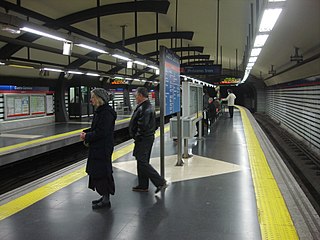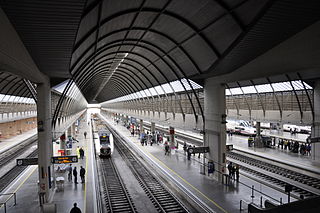
The Madrid Metro is a rapid transit system serving the city of Madrid, capital of Spain. The system is the 14th longest rapid transit system in the world, with a total length of 293 km (182 mi). Its growth between 1995 and 2007 put it among the fastest-growing networks in the world at the time. However, the European debt crisis greatly slowed expansion plans, with many projects being postponed and canceled. Unlike normal Spanish road and rail traffic, which drive on the right, Madrid Metro trains use left-hand running on all lines because traffic in Madrid drove on the left until 1924, five years after the system started operating.

Line B of the Buenos Aires Underground runs 11.75 kilometres (7.30 mi) from Leandro N. Alem to Juan Manuel de Rosas in Villa Urquiza. Line B opened to the public on 17 October 1930.

Line 1 of the Madrid Metro is an underground metro line running from Pinar de Chamartín in the north to Valdecarros in the southeast, via Sol. Today it has 33 stations and spans 24 km (14.9 mi) from end to end.

Line 3 is a rapid transit line of the Madrid Metro in Madrid. It contains 18 stations across 16.424 kilometres (10.205 mi).

Line 4 is a rapid transit line of the Madrid Metro connecting the west and center of Madrid with the said city's northeastern end, running between Argüelles and Pinar de Chamartín. It consists of a total of 23 narrow-gauge stations with 60-metre platforms. Altogether, its route measures just under 15 kilometers, with a journey that lasts approximately 38 minutes. It is operated by a single train model, the 3000 series of the CAF company, which circulates in compositions of 4 cars. This represents a limitation on its maximum passenger capacity per train, which is compensated by one of the highest frequencies in the entire network.

Line 6 of the Madrid Metro opened originally between Cuatro Caminos and Pacifico in 1979. This is one of two circular lines in Madrid, but unlike Line 12, it did not open as a full circle. The circle was completed in 1995, taking four stages from its original opening. It has a length of 23.5 km (14.6 mi) and is coloured grey on route maps.

Line 5 is a rapid transit line in the Madrid Metro system since 5 June 1968. It is the fourth most used line of the Madrid system, transporting 64 million passengers a year. It is 27 kilometers long.

MetroCentro is a tram system serving the centre of the city Seville, in Andalusia, Spain. It began operating in October 2007. The tram is operated by TUSSAM, which is a municipally owned corporation tasked with the operation of the bus and tram system of Seville.

Avenida de América is a multimodal station in Madrid, Spain that services Madrid Metro Line 4, Line 6, Line 7, and Line 9, as well as city buses and intercity and long-distance coaches. Between 1986 and 1996, it also served Line 8. The station is located below the intersections of Avenida de América and Francisco Silvela and Príncipe de Vergara streets. The station consists of several underground levels, with the bus terminal located in the upper three and the Metro station located in the lower four. It serves the neighborhood of Prosperidad and El Viso in Chamartín district and La Guindalera in Salamanca district. It is about 15 minutes from Madrid Barajas Airport and 10 minutes from the city centre of Madrid.

Nuevos Ministerios is a major multimodal rail station on the Madrid Metro and the Cercanías Madrid commuter rail network. It is located beneath the Nuevos Ministerios government complex and the AZCA financial centre at the junction of the Paseo de la Castellana and Joaquín Costa and Raimundo Fernández Villaverde streets in Madrid, Spain. It services the districts of Tetuán, Chamberí, and Chamartín. The station serves Metro Line 6, Line 8, and Line 10, as well as Cercanías Lines C-1, C-2, C-3, C-4, C-7, C-8, and C-10. It is located in Metro fare zone A and Cercanías fare zone 0.

Gran Vía is a station on Line 1 and Line 5 of the Madrid Metro, located underneath the Gran Vía and Red de San Luis Plaza in the Centro district of Madrid. It is located in fare zone A.

Sol is a station on Line 1, Line 2 and Line 3 of the Madrid Metro. It is located in Zone A and is the most central station on the Metro, located at the Puerta del Sol square. Because of its location, it is one of the busiest stations of the Madrid Metro.

Cuatro Caminos is a station on Line 1, Line 2 and Line 6 of the Madrid Metro, located underneath the Cuatro Caminos roundabout on the border of Chamberí and Tetuán districts in Madrid. It is located in fare Zone A. The station was inaugurated on 17 October 1919, and was opened to the public on 31 October 1919.

Ciudad Universitaria is a station on Line 6 of the Madrid Metro, located beneath Complutense avenue in the Ciudad Universitaria ward in the Moncloa-Aravaca district in fare Zone A. It is named after the Ciudad Universitaria, which is home to the Complutense University of Madrid, the Technical University of Madrid, and the National University of Distance Education. The station's platforms feature tilework representing the bear and the strawberry tree, which is a symbol of Madrid. The station is located next to the Ciudad Universitaria underground train storage depot, where most of Line 6's 5000 series trains are stored.

Guzmán el Bueno is a station on Line 6 and Line 7 of the Madrid Metro located underneath the Avenida de la Reina Victoria between the neighborhoods of Vallehermoso in Chamberí district and Ciudad Universitaria in Moncloa-Aravaca district in Madrid. It is in fare Zone A. The station was named after the Calle de Guzmán el Bueno, which is named for the medieval Spanish nobleman Alonso Pérez de Guzmán (1256–1309), known as Guzmán el Bueno.

Diego de León is a station on Line 4, Line 5, and Line 6 of the Madrid Metro, located at the intersections of Francisco Silvela, Diego de León, and Conde de Peñalver streets in the Salamanca district of Madrid. It is in Zone A.

O'Donnell is a station on Line 6 of the Madrid Metro, located near the Royal Mint of Spain and in fare Zone A. It serves the neighborhoods of Goya and Fuente del Berro in the Salamanca district and the neighborhood of Ibiza in the Retiro district of Madrid. The station was inaugurated on 10 October 1979 along with all of the other stations between Pacífico and Cuatro Caminos. The station is named after Calle de O'Donnell, which in turn is named after the 19th-century Spanish politician Leopoldo O'Donnell.

Bilbao is a station on Line 1 and Line 4 of the Madrid Metro. It is located in Zone A and is near to the Glorieta de Bilbao.

Seville–Santa Justa railway station is the major railway station of the Spanish city of Seville, Andalusia. It was opened in 1991 with the inauguration of the Madrid–Seville high-speed rail line, and serves around 9.25 million passengers a year.























